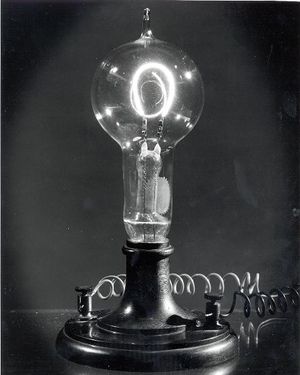Light Bulb Manufacturing
Light bulbs or “lamps” as Thomas Edison called them were almost all made by men at Edison’s Menlo Park factory in the early 1880s, when the Edison lighting system was introduced. These workers included skilled glass blowers and machine operators, who formed the bulb, attached the wire leads, operated the finicky vacuum pump, and performed other operations.
As Americans warmed to electric lighting sales of light bulbs took off. To increase production the skilled tasks needed to make a bulb were broken down into more than 230 smaller tasks so that less-skilled workers could learn to do them easily. During the 1890s, new lamp factories were built around the use of low-skill workers performing simple hand tasks or operating semi-automatic machines. A survey of women’s employment undertaken in 1907, 25 years after the invention of the light bulb, indicated that by that time there were about 370 women and about the same number of men employed making light bulbs or light fixtures.
Of the women, 247 were involved in just one operation—the tedious task of winding the platinum wire used in the filaments into the proper shape. Another 21 women prepared asbestos insulating materials or worked on glassblowing machines to form the balises, or bases of the lamps. Another 26 women assembled the lamps, and 49 worked at miscellaneous jobs such as riveting, soldering, tapping screw holes, inspecting, or scraping porcelains on lamp fixtures. The women and girls who put together lamps and fixtures were paid 4-6 cents each per fixture and could make up to 200 lamps a day. The 247 girls working on winding the platinum wire and blowing balises were paid 10-14 cents an hour. As the years went on, women took over more and more of the jobs in bulb assembly. By 1960 there were more than 20,000 women in the industry, constituting 2/3 of the total number of workers.
